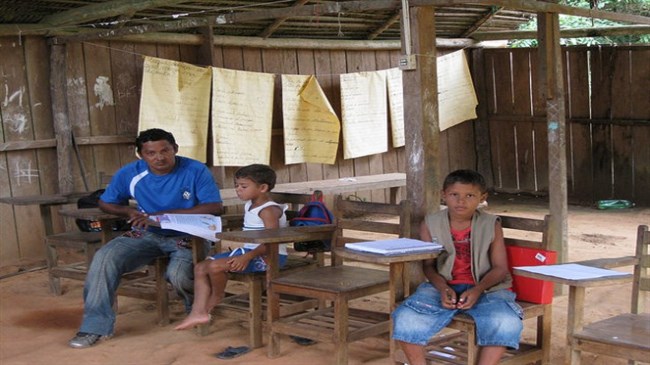
Recognition of the growing need to provide greater access to quality education for indigenous people, which respects cultural differences and local native traditions, is still far from translating into real, long-term public policies, the mayor of the Chilean municipality of Tirúa, Adolfo Millabur, told IPS.
In Chile, for example, “everyone expresses a willingness, but this isn’t put into practice,” said Millabur, whose municipality, 685 km south of Santiago, is located in the region of La Araucanía, home to nearly half of the Mapuche population, the country’s largest indigenous community.
Millabur grew up in the town of El Malo, 35 km from Tirúa. He and his eight siblings would get up every weekday at 5:00 AM and walk 30 km to school, in the town of Antiquina. After a couple of hours in class, they would all set out on the long trek back home.
He doesn’t remember how he learned to read and says he had no idea how to sign a check when he became Chile’s first Mapuche mayor in 1996, at the age of 28.
The right to education is the theme of this year’s Day of the World’s Indigenous Peoples, celebrated Aug. 9.
Access to culturally appropriate education that recognizes diversity and indigenous values and specific needs, including the necessity for native people to learn their mother tongue, is considered key to combating their vulnerability and exclusion.
According to figures from the United Nations Economic Commission for Latin America and the Caribbean (ECLAC), 8.3 percent of the population of Latin America — 45 million of a total of 605 million people — is indigenous.
Of Bolivia’s population of 10.6 million people, 62 percent identify themselves as belonging to an indigenous community, making it the Latin American country with the largest proportion of native people, followed by Guatemala, where 41 percent of the population of 16 million identify themselves as indigenous.
Next in line is Peru, where 24 percent of the population is indigenous, and Mexico, where the proportion is 15 percent.
These are the official statistics, based on the way people self-identify in the census.
According to the 2014 study Indigenous Peoples of Latin America, published in Spanish by ECLAC, there are 826 distinct native groups in the region.
At one extreme is Brazil, with indigenous people making up just 0.5 percent (900,000 people) of the population of 200 million, divided in 305 different groups, followed by Colombia (102 groups), Peru (85) and Mexico (78). At the other extreme are Costa Rica and Panama (nine indigenous peoples each), El Salvador (three) and Uruguay (two).
The Quechua, Nahua, Aymara, Maya Yucateco, Maya K’iche’ and Mapuche are the largest native groups in the region, according to the study.
Despite their large presence and strong influence in the region, the native peoples of Latin America still represent one of the most disadvantaged population groups, the ECLAC report says.
Indigenous people have not only suffered the systematic loss of their territory, with severe consequences for their well-being and way of life, but they are also the population group facing the highest poverty levels and the most marked inequality.
In this scenario, the right to education is essential to the full enjoyment of human and collective rights, and is a powerful tool in the battle to eradicate exclusion and discrimination.
“Indigenous peoples are among the big absentees from educational policies and curriculums,” said Loreto Jara, a researcher on educational policy with the Chile NGO Educación 2020.
“They are absent as historical subjects in the curriculums themselves, but also as social actors in the participatory processes involved in designing the curriculums,” she told IPS.
While progress has been made in recent years with regard to education for Latin America’s indigenous peoples, it is a mistake to see all of the processes as similar just because it is easier to work in a scenario of similarity than to address diversity, she said.
She said education for any native group has a different dynamic than that of our school system, which means it is necessary to incorporate, for example, intercultural teachers in schools.

Add new comment